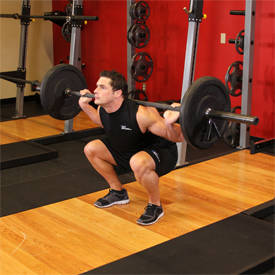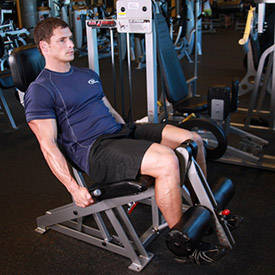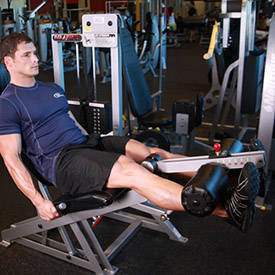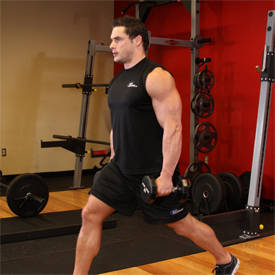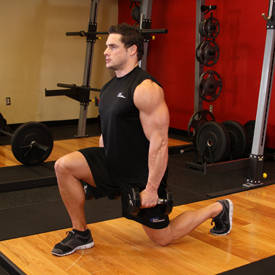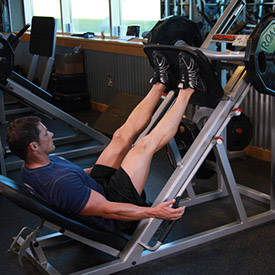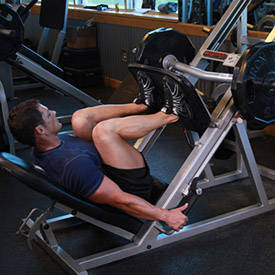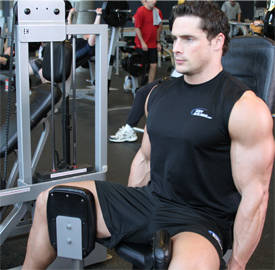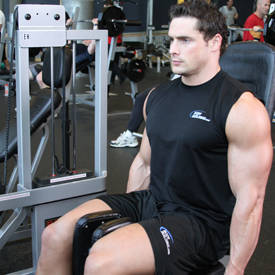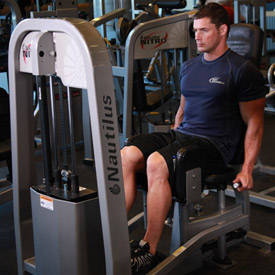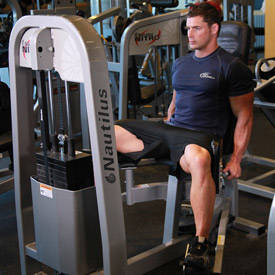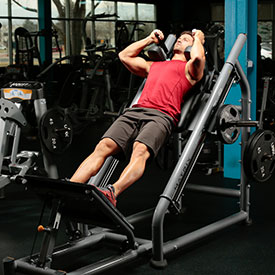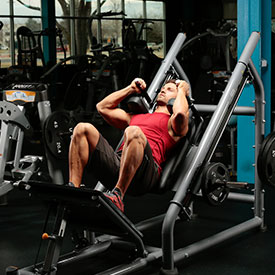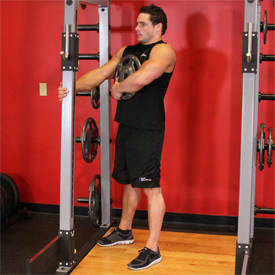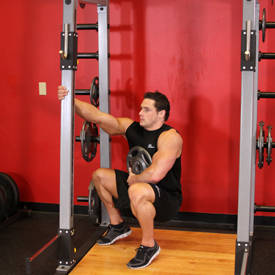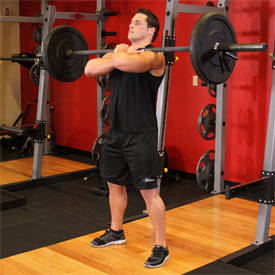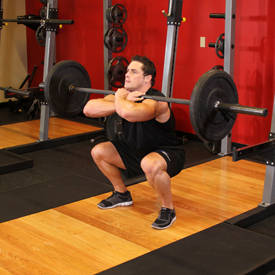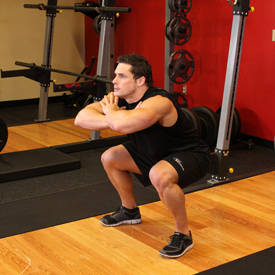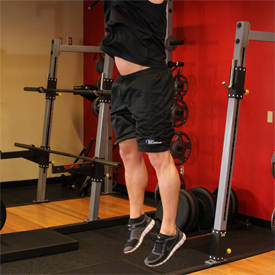This may not be your idea of creating an outrageous physique when you start out, and it wasn't mine when I did. But you know what looks really stupid though? A guy with 18-inch guns, a barrel-shape chest, flaring lats and cannonball delts that suspends his body on toothpick legs. Since the quads are 70 percent of the size of your legs that makes them of vital importance to your overall look. Strong legs and a strong lower back are also the basis of strength in any body.
It's where all the energy originates and these areas contain the largest amounts of endurance fiber. Like the energizer bunny, muscles in these areas put the others to shame because they keep going and going and going, and no matter what weight you throw at them they keep coming back for more.
Large outer quads are also one of the key points in creating the much desired X-frame. On the contrary to what most people believe large legs will not cramp your genital quarters, they will not render you muscle-bound and they will not limit your speed. Unless you take roids and get legs like Tom Platz, that could take away a lot of your speed. But even Platz was very limber and agile for a man with legs like tree trunks.
So stop making excuses and admit that the only reasons you are not training your legs properly are because they are A) hard to train and you don't like to put in the effort and B) not visible very often to you or anyone else and you don't think the effort will pay off. You are wrong on both counts, so lets get to working those puppies...

Constant Tension And The Issue Of Reps
- The quads, along with the back, are the muscles that are most subject to constant tension. The majority of the day they are used in some kind of way and in some cases more intensely than others. Unless you are a world-class sprinter (and if you were you wouldn't be reading this because you'd have huge quads) most of the fiber in your quads will consist of slow-twitch endurance fiber. Logically since you spend much of your time walking and standing and you wouldn't want them to give out at any given time. If you remember from the article on sets and reps the best way to get a lot of the endurance fiber into play, and its not easy, is by increasing the reps.
Slow-twitch and some of the fast-twitch fibers are known as oxidative fiber and as the name suggests they would benefit from exercise that is aerobic to a point. This is in direct opposition to other areas where you keep reps reasonably low to keep work anaerobic to hit the glycolytic fiber that gives you the fast gains. But if a muscle is lagging it may have more oxidative fiber too and it may be better to try higher reps as well.
Now let's get back to the quads. This means because of the large amount of this kind of fiber, you'll want to get between 15 and 20 reps for most leg exercises. This will have you huffing and puffing in no time, but it's exactly that kind of work that will pay off.

To Squat Or Not To Squat?
- Face it, no sane person likes to do
squats
- , and even less people like to do them for sets of 20 or breathing sets. So people try to weasel out by doing leg presses and such, because they are basically the same motion. Well I have news for you, most
leg presses
- have you move the weight while you are sitting still. And all of them have you in a locked position with no balancing of any weight required whatsoever. That's why they are easier.
But exercises where the body moves instead of the weight have been shown to release larger amounts of hormonal substances and therefore speed up protein metabolism and growth. By involving the balancing muscles a squat gives you a total body workout in the aerobic sense to supplement their weekly anaerobic fix and this may lead to new growth overall. So squats are an integral part of a training regimen and one of the few exercises you can and should include all the time or at the very least most of the time.
No exercise puts more meat on your scrawny bones than the free barbell squat. Keep that in mind as you try to avoid doing them and remember my words when you look back on this time and how your toothpick legs haven't grown an inch.

Physiology Of The Muscle
- The quadriceps, following the logic of counting, has four different heads. The outer head which adds most of the size to the much desired X-frame is called the vastus lateralis and is mostly exercised by keeping the legs close together and the toes pointed forward in pressing exercises like the squat and the leg press. Way on the other side is the vastus medialis or inner head which adds most of the definition and mass to the inner legs, provides the separation between the quads and hams in leg poses and is displayed mostly in leg shots.
To pay close attention to this take the legs further apart and point your toes outward. Both these muscles are longer than the inner muscles and to train the lower part you can do things like leg extensions and so on. The point of contraction emphasizes size and definition in the leg near the knee joint. The other two muscles from the inner head, the vastus internalis and the Rectus femoris. They are shorter and situated higher on the leg.
They make the teardrop shape near the groin and they lift most of the weight in the bottom of a rep, from stretch point upwards. So logically you'll hit these muscles by going deep on squats and using bottom-half reps of the leg press. It's a complex muscle with many sides and angles, but in the end training options are limited and very strict. The How to is explained in the following paragraphs.
Somewhat included in quad-training is hitting the behind as well. The glutes, which contract the legs backwards, are made up of a single muscle-group, rather large too, called the gluteus maximus. Though specialized machines exist to train the glutes, and you should use them at your own discretion, the best way to work them still is by going deep on squats and keeping your feet flat on the floor as you do this. This still stimulates more of the glutes than any machine invented to date.

Training Your Quadriceps
- So the principle exercise for the quads is the
squat
- , so much so that it is 60 percent of the solution if you learn how to do them correctly and vary your positioning. We are of course talking about the free weight barbell squat, preferably performed in the confines of a squat rack or at the very least with one or two spotters. Load up a barbell and let it rest comfortably on our shoulders, if its heavy you have to find the sweet spot a bit lower, on your traps, where it will cause the least discomfort.
Stand with your feet shoulder width apart, toes pointing straight forward. Keeping the back straight, the head fixed in a straight line looking ahead of you, bend through your knees. You should come down in an arcing motion to the back, because your knees should point straight up at the ceiling at all times and your back should stay straight. This is the reason you should never perform a squat in a smith rack because the motion of the barbell is linear and either makes your back bend forward or your lower legs backward, both putting you in a hazardous position. Go down until you are practically sitting on your heels.
- Some think they can get away with squats that go halfway, and athletes training for strength like football players can, but we can't. Going all the way down doesn't just involve hamstring work, it also hits the part of the quads that is hard to hit with any other exercise: the upper part. When performing squats some say to elevate your heels so you can isolate the quads but this too is unsafe. In fact one safeguard you can use is to lower all the way down, make sure your feet stay flat on the floor at all times and then push as though you want to dig your heels into the ground.
This ensures you will be lifting with the legs and not the back. This is the standard squat. It is always the basis of your program and should take up at least 5 or 6 sets. If you encounter weaknesses in the inner or outer thigh, don't drop squats to correct matters, adapt squats and use them to correct matters.
Start by doing two regular sets then do the other 3-4 in a specific manner. Set legs further apart and point toes more outward if you want to emphasize the inner portion and set your feet firmly together if you want to emphasize the outer portion. Note that this last one is hard to balance so make sure a spotter is present.
Another major player in leg training is the leg extension. Many people now consider this machine a waste or a shaping exercise. Neither is true, but when performed after the squat it stimulates very little and even then only the lower portion which gets a lot of action anyway. The proper way to use it, if at all, is not for the weak.
- Considering your squats will circle around the 20 reps, its hard to do anything before, but if you really want to get intense, pre-exhaust the quads with leg extensions. Go as far back as you can and when you go up hold the contraction for a count. Go for 12-15 heavy reps at a time for 2-4 sets, then rest a minute and move on to do 5-6 sets of squats. You may very well opt to call that a day. That is how hard it can be when done properly. And with all due respect, with those 7-10 sets you did get a full quad workout and if you are really tired you can call it a day...
Some may think that is not enough. For me that changes week to week and some weeks I do more than others in this case here are some suggestions.
Doing lunges is a good way of getting an extra pump to go. A proper lunge is either done with a barbell on your shoulders or a dumbbell in each hand to weigh you down. With feet next to each other step one foot forward for about 5 feet and bend all the way down keeping the back leg reasonably straight and bending the front leg to 90 degrees or smaller if you can to really tense the quads. Now push up on that leg as you bring the other one back right next to it and repeat with the other leg. That is one rep.
- It's not easy I warn you. What I'll do sometimes is just go for the hardest part and do static lunges. The setup is the same. Now take a step forward for about 3 and a half feet and stay in that position. Now bend your front leg to 90 degrees or forward and keeping both feet where they are push yourself back up. That is one rep and you do a few (10-15, what you feel best) and then switch legs. This keeps the pressure on longer, takes a lot of the balancing work out of it if you use a barbell and still gives you the same amount of work in less time.
The leg press has its niche in your leg training as well, but not as an alternative for squats. An advanced lifter can opt to alternate the two from week to week, but an advanced lifter has the mass and skill to do this. So why do this exercises at all, if squats are better and you don't want to be redundant? Well doing leg extensions you hit the lower part of the quads, squats hit the legs full on. What if you added upper part only leg presses? This will give the hard to hit upper part some extra work and it adds a serious degree of difficulty to this exercise because of constant tension. Coincidentally the best way of working quads as stated earlier in this article.
Adductor
- and
abductor
- machines, that exercise the muscle on the side and the inner thigh, and work to open and close the legs respectively, are optional. They gain enough functional strength on full squats and their variations, and they don't have a lot to offer in terms of size. Yet some bodybuilders swear by these exercises whilst others shun them and they all have great legs. So who to believe? Well give them a shot and see what gives. If you feel you don't need them don't do them, but including them once in a while is a nice variation and it can never hurt to add that bit of extra work. But normally it's not a necessity.

Other Exercises
- There is a limit to how much you can do to help your quad mass along, but with the squat in there there is little chance of selling yourself short. If you learn to do that one correctly, you have got it made. Mass will come eventually. Just stay strict, stay heavy and keep the reps high. But there are a few you may wish to add to your program as well if for some reason you can't get around to using the previous.
Hack Squats are usually done in a machine that is at a slight decline, with a board to lock your feet and this is a variation to the squat that isolates the quads more. I wouldn't suggest throwing away your barbell just yet, but using this one instead once in a while can be a nice change that really helps. Of course the added benefits of a full squat are lost but that doesn't mean you should discard this one.
- One exercise I recommend to some of my intermediate students is the reverse hack squat. Sit in the hack squat machine but facing the pad. Because of the position the legs are in now and your feet are quite a bit back its almost as if you are pushing up and forward, making sure you hit nothing but quads.
And don't let the name fool you into believing this is easy, but one exercise that is great for people on the go or trying to put the finishing touches to their leg day may be sissy squats. With the legs locked into position in a special sissy squat rack, you bend back and down, keeping back straight. As if you were sitting down. The exaggerated arc on this will provide intensity you have never felt before and after a few sets you'll know this isn't for sissies.
If you don't have such a station, one way of doing it is by standing in a door frame and using one hand to keep your from falling back as you do this. Avoid using the hand too much as you go down and come back up. One of the best exercises for legs if you are in a hotel-room and have no equipment at your disposal.
If you tire of regular squats, seek more pressure in the front of the quads and an overall more difficult exercise, do front squats or Zercher squats. Holding the barbell in your arms as if cradling a baby, resting it in the crease of the elbows, perform your basic squat. I'm convinced you'll find this a very effective way of doing squats and possible safer since you can throw off the weight. If you need more of a challenge, try doing them as Zercher did them and scoop the barbell off the floor by bending through your knees reaching forward with the arms beneath the bar and carrying it in the elbows. Good luck.
- Outdated as they are, you may wish to try
jumping squats
- to stimulate more fiber and create more functional strength in the legs. Basketball and volleyball players can really use these to good purpose. Use less weight, about half of the squat, go down, and explode back up, jumping in the air as you reach the top and lower back to the squat as you come down. One warning, it's not too healthy for the knees.

Intensity Measures
- Stimulating a lot of slow fibers you need to create a lot of
- in the legs. And here you were thinking that aerobic sets and lots of squats were enough. Some things you may want to try when doing squats to make them a bit harder or longer or whatever are the following:
One-and-a-half squats using the principle by the same name where you lower all the way down, come back up halfway, lower again and then go up all the way again. This would constitute one rep and you would do about 15 of them per set.
Breathing sets are something I apply regularly. Load your barbell with a weight you can handle for 10 reps, then get those ten and force out 10 more at any cost no matter how long it takes. When you sit down panting and catching your breath for 3 minutes you'll know why they are called breathing sets.
I already introduced you to the pre-exhaust way of doing things when you start with extensions and move on to squats. But what if you did them in a superset? Could be an idea...
- Of course any and all principles of intensity described in the article "
- " can be applied here, but these are some of the favorites most often linked to quad training. So go ahead and give your training an upgrade by adding these to your squatting regimen. Or try combining them. Try doing 15 sets of 1-and-a-halfs with a weight you could handle for only 9 or 10, alternating each set with a heavy 12-rep set of leg extensions. Finish with some bottom half-leg presses and a few sets of lunges and watch yourself waggle home. If you can manage...

Weak Point Training
- I already gave you the best way of overcoming weak points when I discussed squat variations, and these variations apply to the leg press as well. I suggest you take these things and commit them to memory because weak legs, like weak anything, will hinder performance and look. Lack of outer thighs ruins your chances of an X-frame and seriously detracts from lower body size. Lack of inner thighs may not be so hazardous in every day life since most of the fair sex absolutely detest big legs, but in a competition any pose where one leg is ahead of the other displays a lot of the inner thigh and puts you in a place where you could lose points.
Deep and full squats and bottom-half leg presses will cure any problem with the upper thigh, which is also only a problem onstage, but a big one since it makes you look as if your legs were sewn on. It detracts from your thin waist and diamond abdominals as well. Lower thigh problems are rare, can be helped with leg extensions and holding the contraction when you come back up out of a squat, but having these will make your knees look big, destroy your symmetry and take the attention away from your calves. So none of these things will aid you in any way.
Avoiding and overcoming weak points, I will say it again, is one of the foundations of our sport. Though the original standards are nothing but a relic to IFBB pro judges, some of us still like to think that symmetry and proportion are the cornerstones of the iron game...

Progression of Training
- I don't expect your routine will change immensely over the years. Once you get to a certain number of sets and see good results, usually you'll stick to it. Squats, extensions, presses and lunges are the best exercises and I suspect you'll adhere to those mostly as well. So as you progress instead of making it more complicated, changing it or adding to your workload, simply make matters more difficult on yourself by introducing new measures of intensity. The three described above will go a long way, but the article I referred to contains at least twenty more ways of increasing the intensity of your quad workout, so have a look.
You may not become Paul Demayo or Tom Platz overnight and looking at those monstrous quads, I'm not so sure you would want to be, but remember that this is mostly slow-twitch fiber, and that it grows slowly but steadily. Commit yourself to a proper program and good nutrition and pretty soon you'll have thighs some can only dream about.


